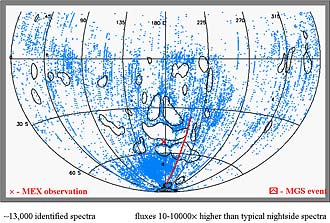Published online today in Geophysical Research Letters:
Sears, Derek W. G.; Chittenden, Julie D.
On laboratory simulation and the temperature dependence of the evaporation rate of brine on Mars
Geophys. Res. Lett., Vol. 32, No. 23, L23203
10.1029/2005GL024154
14 December 2005
Abstract
See also an earlier press release:
Simulations Show Liquid Water Could Exist on Mars
University of Arkanasas Daily News
FOR RELEASE: Monday, November 07, 2005
Full Version: Grl (december 14, 2005)
This is an interesting article since we are learning which southern hemisphere places are the best places to protect the astronauts from the wind and radiation solar with its wider magnetic field protection shield.
The most places are in the southern of Gusev's crater:

A plot of the 13,000 auroral events detected in the past six years by Mars Global Surveyor shows them clustering around the margins of the regions of strong surface magnetic field, mostly in the southern hemisphere. The margins are where the magnetic field lines converge on the surface, funneling electrons that crash into atmospheric carbon dioxide and generate the ultraviolet flashes. The red X marks the spot where Mars Express first detected an aurora last year. (Credit: David Brain & Jasper Halekas/SSL)
The surface magnetic fields, Brain said, are produced by highly magnetized rock that occurs in patches up to 1,000 kilometers wide and 10 kilometers deep. These patches probably retain magnetism left from when Mars had a global field in a way similar to what occurs when a needle is stroked with a magnet, inducing magnetization that remains even after the magnet is withdrawn. When Mars' global field died out billions of years ago, the solar wind was able to strip the atmosphere away. Only the strong crustal fields are still around to protect portions of the surface.
"We call them mini-magnetospheres, because they are strong enough to stand off the solar wind," Lin said, noting that the fields extend up to 1,300 kilometers above the surface. Nevertheless, the strongest Martian magnetic field is 50 times weaker than the field at the Earth's surface. It's hard to explain how these fields are able to funnel and accelerate the solar wind efficiently enough to generate an aurora, he said.
However, the martian magnetic field is still 50 times weaker than the field at the Earth but these places are much better than the others places that has no magnetic fields protection.
Rodolfo
P.D.On the other hand, ESA is learning from Aurora as a new type propulsion which might be much better than ion electric propulsion.
The most places are in the southern of Gusev's crater:

A plot of the 13,000 auroral events detected in the past six years by Mars Global Surveyor shows them clustering around the margins of the regions of strong surface magnetic field, mostly in the southern hemisphere. The margins are where the magnetic field lines converge on the surface, funneling electrons that crash into atmospheric carbon dioxide and generate the ultraviolet flashes. The red X marks the spot where Mars Express first detected an aurora last year. (Credit: David Brain & Jasper Halekas/SSL)
The surface magnetic fields, Brain said, are produced by highly magnetized rock that occurs in patches up to 1,000 kilometers wide and 10 kilometers deep. These patches probably retain magnetism left from when Mars had a global field in a way similar to what occurs when a needle is stroked with a magnet, inducing magnetization that remains even after the magnet is withdrawn. When Mars' global field died out billions of years ago, the solar wind was able to strip the atmosphere away. Only the strong crustal fields are still around to protect portions of the surface.
"We call them mini-magnetospheres, because they are strong enough to stand off the solar wind," Lin said, noting that the fields extend up to 1,300 kilometers above the surface. Nevertheless, the strongest Martian magnetic field is 50 times weaker than the field at the Earth's surface. It's hard to explain how these fields are able to funnel and accelerate the solar wind efficiently enough to generate an aurora, he said.
However, the martian magnetic field is still 50 times weaker than the field at the Earth but these places are much better than the others places that has no magnetic fields protection.
Rodolfo
P.D.On the other hand, ESA is learning from Aurora as a new type propulsion which might be much better than ion electric propulsion.
This is a "lo-fi" version of our main content. To view the full version with more information, formatting and images, please click here.